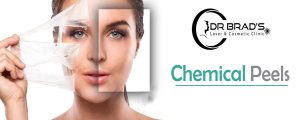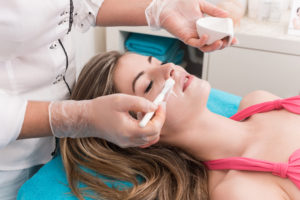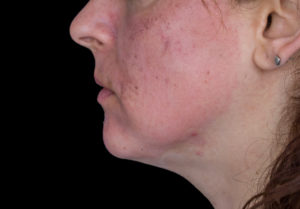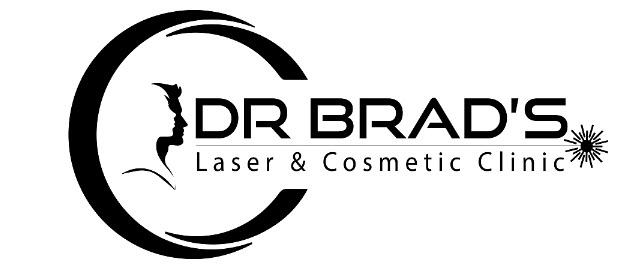
A medical-grade chemical peel is a fundamental essential of any skincare regime designed to protect and rejuvenate the skin.

The peel solution is applied gently and evenly with a light brush or cotton buds before being neutralised at just the right time.
What is a Medical Grade Chemical Peel?
Medical grade chemical peel treatments involve the application of a carefully formulated and manufactured solution of acids and co-factors to carefully pre-prepared skin, delivered by a doctor under carefully controlled conditions to obtain predictably impressive results with a minimum of risk.
They are more intense and effective than home or personal use chemical peel kits or those milder peels offered by your local beauty salon which would usually be categorised as “Very Superficial“.
Medical grade skin peels work by exfoliating dead cells, revealing fresh skin below. It enhances cell growth and turnover which all combine to make skin look younger and healthier.
Listen to what Dr Brad has to say about his approach to chemical peels.
How are Medical Grade Chemical Peels Categorised?
They can be categorised into one of three categories: superficial, medium or deep.
- Superficial chemical peels only penetrate into the epidermis (the top layer of the skin).
People of any age, skin type or racial origin can use this type of peel on almost any part of the body. Teenagers with acne can use it too although I only treat people 18 years of age and over. This is often referred to as a “lunchtime peel” because people could theoretically receive this type of chemical peel treatment and then return to the workplace without looking too inflamed.
- Medium/Deep chemical peels can penetrate into the papillary dermis (upper part of the middle layer of the skin).
Suitable for any Caucasian over the age of 21 wanting a more intense peel experience and result and who are prepared to experience more intense temporary inflammation and peeling than with a superficial peel. “Down Time” of 7-10 days is not unusual with this intensive treatment. People with darker skin types do not usually have this type of peel due to the higher risk of post-inflammatory hyperpigmentation (PIH).
Watch Dr Brad performing a light chemical peel. in the video below.
What Conditions Can Be Treated Effectively by Medical Grade Chemical Peels?
- Aged Skin ie photo-damage, sagging and wrinkling.
This is damage caused by the cumulative effects of exposure to the sun's ultra violet rays over the years. This causes skin to lose collagen, become thin and affected by pigment spots (solar lentigines). The loss of collagen and damage to microscopic elastin fibres causes a loss of volume and elasticity that promotes the development of fine lines and wrinkles. A series of up to 6 superficial chemical peels can result in a noticeable improvement in all of these aspects. TCA peels get results faster though.
- Acne.
Acne vulgaris is a common and prominent problem for all too many young and older people. The causes and mechanisms of acne development are incompletely understood by medical science and over the counter treatments can be frustratingly ineffective. Adults may benefit from any of my superficial or medium depth peels. Teenagers may benefit from a superficial peel if they have written parental consent. Teenagers over the age of 18 may receive this treatment. Medical grade chemical peels can help to reduce the frequency and severity of acne symptoms whilst also improving the appearance of pore size, post-inflammatory hyper-pigmentation and scarring. The more severe the scarring, the more a TCA CROSS or medium/deep peel might be preferred over a superficial peel.
- Pigmentation Problems
A common pigmentation problem I treat with chemical peels is melasma/chloasma, which is where some areas of the skin exhibit patchy areas of darkness. This tends to occur in UV exposed areas such as the face and is caused by selective hyperactivity of melanocytes in the epidermis. A chemical peel is effective in removing excess melanocytes from the epidermis resulting in an improvement in appearance. A skin lightening cream (also known as a “bleaching cream”) is used in conjunction with my peels for best results.
Which Range of Chemical Peels Does Dr Brad Offer?
- For superficial glycolic peels: I use either pure glycolic 20%, 35%, 50% or 70% alone.
OR
- Dr Brad's Combi-Peel: A custom glycolic combined with 30% citric acid and mandelic acid.
These peels typically result in a refreshed look with minimal or no recovery downtime.
Pricing.
A course of 6 peels is recommended with 3-5 week intervals.
Full face (glycolic 20%, 35%, 50%, 70%): £105 (5% off any course of 6).
Dr Brad’s Combi-Peel for £125 per session (5% off any course of 6).
Watch this video of Dr Brad performing a glycolic acid chemical peel:
- For medium/deep peels, I use buffered 15% Trichloroacetic Acid (TCA) peels.
These 15% TCA peels are more intense and can deliver faster, more effective results than a superficial peel.
The trade off is the acceptance that your skin will obviously be peeling few days than with the superficial peel.
The outer layer of the skin can become brown and crusty as it separates and peels off over a week or so.

Typical appearance of skin 24 hours after a medium depth TCA peel before the crusting has started.
A medium depth peel can be repeated once after 4-6 weeks.
A medium depth peel can then be repeated annually if you desire and/or you can optionally use a superficial glycolic acid peel 6-8 weekly throughout the year to keep you looking your best.
Whatever you decide, even if you only have the one medium depth peel, the visible benefits will last for a long time.
Dr Brad will treat your Full Face for just £225.
- For deeper focal peels, I use 43% Trichloroacetic Acid.
I use this product to treat very small areas (less than 1cm diameter) of particularly prominent or stubborn hyperpigmentation or UV induced brown spots. I often use this in conjunction with a medium depth 15% TCA peel regime in addition to bleaching agents for home use.
- TCA CROSS
I can offer you TCA C.R.O.S.S. treatment for scars caused by acne, chickenpox etc. in his private Bristol clinic.
TCA C.R.O.S.S. is a an acronym for TriChloroAcetic Chemical Reconstruction of Skin Scars.
CLICK HERE TO LEARN MORE ABOUT DR BRAD'S TCA CROSS TREATMENT.
Summary.
In conclusion, I am very pleased to be able to bring these highly effective and modern medical grade chemical peel treatments to my patients in Bristol.
Improving the quality of your skin is equally as important as any other aesthetic treatment so can be used alongside toxinjectables, dermal fillers, PRP and laser to give the best results.
Call on 07588971425 or email for a consultation today.

A medical-grade chemical peel is a fundamental essential of any skincare regime designed to protect and rejuvenate the skin.

The peel solution is applied gently and evenly with a light brush or cotton buds before being neutralised at just the right time.
What is a Medical Grade Chemical Peel?
Medical grade chemical peel treatments involve the application of a carefully formulated and manufactured solution of acids and co-factors to carefully pre-prepared skin, delivered by a doctor under carefully controlled conditions to obtain predictably impressive results with a minimum of risk.
They are more intense and effective than home or personal use chemical peel kits or those milder peels offered by your local beauty salon which would usually be categorised as “Very Superficial“.
Medical grade skin peels work by exfoliating dead cells, revealing fresh skin below. It enhances cell growth and turnover which all combine to make skin look younger and healthier.
Listen to what Dr Brad has to say about his approach to chemical peels.
How are Medical Grade Chemical Peels Categorised?
They can be categorised into one of three categories: superficial, medium or deep.
- Superficial chemical peels only penetrate into the epidermis (the top layer of the skin).
People of any age, skin type or racial origin can use this type of peel on almost any part of the body. Teenagers with acne can use it too although I only treat people 18 years of age and over. This is often referred to as a “lunchtime peel” because people could theoretically receive this type of chemical peel treatment and then return to the workplace without looking too inflamed.
- Medium/Deep chemical peels can penetrate into the papillary dermis (upper part of the middle layer of the skin).
Suitable for any Caucasian over the age of 21 wanting a more intense peel experience and result and who are prepared to experience more intense temporary inflammation and peeling than with a superficial peel. “Down Time” of 7-10 days is not unusual with this intensive treatment. People with darker skin types do not usually have this type of peel due to the higher risk of post-inflammatory hyperpigmentation (PIH).
Watch Dr Brad performing a light chemical peel. in the video below.
What Conditions Can Be Treated Effectively by Medical Grade Chemical Peels?
- Aged Skin ie photo-damage, sagging and wrinkling.
This is damage caused by the cumulative effects of exposure to the sun's ultra violet rays over the years. This causes skin to lose collagen, become thin and affected by pigment spots (solar lentigines). The loss of collagen and damage to microscopic elastin fibres causes a loss of volume and elasticity that promotes the development of fine lines and wrinkles. A series of up to 6 superficial chemical peels can result in a noticeable improvement in all of these aspects. TCA peels get results faster though.
- Acne.
Acne vulgaris is a common and prominent problem for all too many young and older people. The causes and mechanisms of acne development are incompletely understood by medical science and over the counter treatments can be frustratingly ineffective. Adults may benefit from any of my superficial or medium depth peels. Teenagers may benefit from a superficial peel if they have written parental consent. Teenagers over the age of 18 may receive this treatment. Medical grade chemical peels can help to reduce the frequency and severity of acne symptoms whilst also improving the appearance of pore size, post-inflammatory hyper-pigmentation and scarring. The more severe the scarring, the more a TCA CROSS or medium/deep peel might be preferred over a superficial peel.
- Pigmentation Problems
A common pigmentation problem I treat with chemical peels is melasma/chloasma, which is where some areas of the skin exhibit patchy areas of darkness. This tends to occur in UV exposed areas such as the face and is caused by selective hyperactivity of melanocytes in the epidermis. A chemical peel is effective in removing excess melanocytes from the epidermis resulting in an improvement in appearance. A skin lightening cream (also known as a “bleaching cream”) is used in conjunction with my peels for best results.
Which Range of Chemical Peels Does Dr Brad Offer?
- For superficial glycolic peels: I use either pure glycolic 20%, 35%, 50% or 70% alone.
OR
- Dr Brad's Combi-Peel: A custom glycolic combined with 30% citric acid and mandelic acid.
These peels typically result in a refreshed look with minimal or no recovery downtime.
Pricing.
A course of 6 peels is recommended with 3-5 week intervals.
Full face (glycolic 20%, 35%, 50%, 70%): £105 (5% off any course of 6).
Dr Brad’s Combi-Peel for £125 per session (5% off any course of 6).
Watch this video of Dr Brad performing a glycolic acid chemical peel:
- For medium/deep peels, I use buffered 15% Trichloroacetic Acid (TCA) peels.
These 15% TCA peels are more intense and can deliver faster, more effective results than a superficial peel.
The trade off is the acceptance that your skin will obviously be peeling few days than with the superficial peel.
The outer layer of the skin can become brown and crusty as it separates and peels off over a week or so.
Pricing.
Full Face £225

Typical appearance of skin 24 hours after a medium depth TCA peel before the crusting has started.
A medium depth peel can be repeated once after 4-6 weeks.
A medium depth peel can then be repeated annually if you desire and/or you can optionally use a superficial glycolic acid peel 6-8 weekly throughout the year to keep you looking your best.
Whatever you decide, even if you only have the one medium depth peel, the visible benefits will last for a long time.
- For deeper focal peels, I use 43% Trichloroacetic Acid.
I use this product to treat very small areas (less than 1cm diameter) of particularly prominent or stubborn hyperpigmentation or UV induced brown spots. I often use this in conjunction with a medium depth 15% TCA peel regime in addition to bleaching agents for home use.
- TCA CROSS
I can offer you TCA C.R.O.S.S. treatment for scars caused by acne, chickenpox etc. in his private Bristol clinic.
TCA C.R.O.S.S. is a an acronym for TriChloroAcetic Chemical Reconstruction of Skin Scars.
CLICK HERE TO LEARN MORE ABOUT DR BRAD'S TCA CROSS TREATMENT.
Summary.
In conclusion, I am very pleased to be able to bring these highly effective and modern medical grade chemical peel treatments to my patients in Bristol.
Improving the quality of your skin is equally as important as any other aesthetic treatment so can be used alongside Botulinum toxin injections, dermal fillers, PRP and laser to give the best results.
Call on 07588971425 or email for a consultation today.
